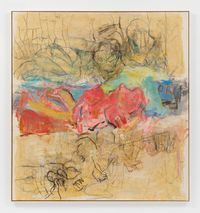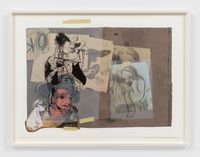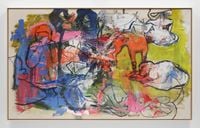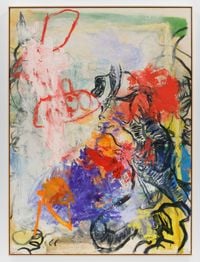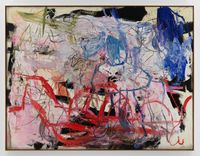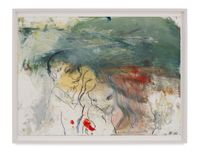From her figurative renditions of women to her later gestural paintings, artist Rita Ackermann explores the relationship between colour, form, and line, as well as the action and processes of addition and erasure.
Read MoreRita Ackermann studied at the Academy of Fine Arts in her native Budapest (1989—1992), before moving to New York to attend the city's School of Painting, Drawing and Sculpture (1992—1993).
In New York, the artist encountered a rich art scene in transition, which encompassed the dawn of the Internet age and interdisciplinary collaborations across the arts and publishing industries.
Many of Ackermann's drawings and paintings from this period feature young women, who are often rendered in confident lines and lightly dressed, accompanied by an erratic application of red that implied violence or its aftermath.
Over the years, Ackermann has developed a process of disappearance, in which she draws on canvas primed with chalkboard paint then washes parts of the drawing away. Resulting works, such as The Wall Coming Down (2014), show the sweeping traces of her gestures—a clenched fist, perhaps—the rest of which fade into clouds of chalk. At once visible and erased, Ackeramnn's chalkboard painting court a fluid existence between figuration and abstraction.
Ackermann's original drawings on chalk-primed canvases often derive from her earlier female forms, which have been compared to nymphs. In her 2015 interview with Whitehot Magazine, the artist said that they 'haunted me all through my career,' yet their lines provide adequate starting points for 'destruction in order to re-construct them into something completely new.'
In both her chalkboard paintings and other artworks, Rita Ackermann focuses on the sensation of process by documenting the gestures made by her hand. The artist also works with canvases on the floor or the wall, allowing a more direct engagement with her materials.
Mama '19, Rita Ackermann's 2020 solo exhibition at Hauser & Wirth, New York, presented a new series of automatic drawings and paintings depicting an explosion of colour and turbulent pencil lines. As in her other works, familiar forms may begin to rise, only to withdraw into a web of forms. Despite its title, 'Mama', Ackermann deviates away from a coherent narrative; her use of the term does, however, prompt the viewer to foster a more intimate understanding of the works.
Mama '19 was followed by Mama '20 at Hauser & Wirth, Zurich later that year, and by Mama '21 at the gallery's Monaco location in 2021.
Rita Ackermann's paintings have been adapted to fashion, notably for the Supreme x Rita Ackermann collaboration for the Fall/Winter 2019 season and for Chloé in Fall 2020, which revolved around the artist's collage If You Listen Carefully . . . I'll Show You How to Dance . . . (1995).
Selected solo exhibitions of Rita Ackermann's work include Rita Ackermann & Andro Wekua, Fergus McCaffrey, Tokyo (2021); Rita Ackermann. Brother and Sister, Hauser & Wirth, Zürich (2019); Rita Ackermann: Nudes and Jacket, KARMA, New York (2017); The Aesthetics of Disappearance, Malmö Konsthall, Sweden (2016); Meditation on Violence — Hair Wash, Sammlung Friedrichshof Stadtraum, Vienna (2014); and Rita Ackermann, Museum of Contemporary Art, Miami (2012).
Selected group exhibitions include The World According to, Pace Gallery, New York (2019); Michael Jackson: On the Wall, National Portrait Gallery, London (2018); Surface Work, Victoria Miro, London (2018); Extreme Drawing: Ballpoint Pen Drawing Since 1950, Aldrich Museum of Contemporary Art, Connecticut (2013); Mix / Remix, Luhring Augustine, New York (2012); Flash Light / Festival of Ideas, New Museum, New York (2011); and Looking at Music: 3.0, Museum of Modern Art, New York (2011).
Sherry Paik | Ocula | 2021
